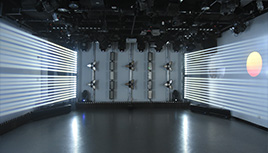The Ultimate Guide to Image Light and Gobo Light: Everything You Need to Know
2024-07-02 Post By: Longmangroup
Introduction
Lighting is a crucial element in any design, whether it's for a concert, a theater production, a wedding, or a corporate event. Two innovative lighting technologies that have significantly transformed the industry are image light and gobo light. These tools can create stunning visual effects and add a new dimension to any setting. But what exactly are they, and how do they work? Let's dive in and explore everything you need to know about image light and gobo light.
Understanding Image Light
Definition and Basic Concept
Image light is a type of lighting that projects images or patterns onto surfaces. This can be done using various types of projectors and lenses, which allow for a wide range of creative possibilities.
Common Uses of Image Light
Image lights are commonly used in events like weddings, corporate presentations, and art installations. They can project company logos, decorative patterns, or thematic images that enhance the atmosphere of the event.
Advantages of Using Image Light
Using image light allows for high customization and flexibility. You can easily change the projected images to match the theme of your event or to convey different messages throughout a presentation. Additionally, image lights can add a layer of visual interest that captivates the audience.
Exploring Gobo Light
What is a Gobo Light?
A gobo light is a type of lighting that uses a template or stencil (known as a gobo) to project shapes, patterns, or logos. The term "gobo" stands for "goes before optics, " which describes its placement in the lighting fixture.
Types of Gobo Lights
There are several types of gobo lights, including:
- Steel Gobos: Durable and affordable, often used for simple patterns.
- Glass Gobos: Allow for more intricate designs and can include colors.
- Plastic Gobos: Ideal for short-term use and custom designs.
How Gobo Lights Work
Gobo lights work by placing a gobo template inside a lighting fixture. The light passes through the gobo, casting the design onto a surface. By adjusting the focus and angle, you can control the clarity and position of the projected image.
Image Light vs. Gobo Light
Key Differences
While both image light and gobo light are used to project images, the main difference lies in their method. Image light uses digital projectors to display high-resolution images, while gobo light uses physical templates to create patterns.
Applications Where Each Shines
- Image Light: Best for dynamic and detailed projections, such as videos or complex graphics.
- Gobo Light: Ideal for sharp, static designs like logos or geometric patterns.
Technical Aspects of Image Light
Types of Image Light Sources
Image lights can be sourced from various types of projectors, including LED, LCD, and DLP projectors. Each type offers different advantages in terms of brightness, color accuracy, and resolution.
Technical Specifications to Consider
When choosing an image light, consider the following specs:
- Brightness: Measured in lumens, higher brightness is essential for large or well-lit venues.
- Resolution: Determines the clarity of the projected image.
- Contrast Ratio: Affects the depth and detail of the image.
Installation and Setup Tips
To get the best results from your image light:
- Ensure the projector is aligned correctly.
- Adjust the focus for a clear image.
- Use appropriate mounting hardware for stability.
Technical Aspects of Gobo Light
Types of Gobo Materials
Gobos can be made from various materials, each suited for different applications:
- Steel: Durable and cost-effective for simple designs.
- Glass: Offers high detail and color options but is more fragile.
- Plastic: Good for custom designs but less durable.
Technical Specifications to Consider
Important specs for gobo lights include:
- Beam Angle: Determines the spread of the light.
- Wattage: Affects the brightness of the projection.
- Fixture Compatibility: Ensure the gobo fits your lighting fixture.
Installation and Setup Tips
To set up a gobo light:
- Insert the gobo into the holder.
- Adjust the focus for a sharp projection.
- Position the light to achieve the desired effect.
Creative Uses of Image Light
Enhancing Ambiance with Image Light
Image light can transform any space by projecting ambient patterns or thematic visuals. For example, projecting water ripples at a beach-themed party can enhance the atmosphere significantly.
Artistic Applications
Artists often use image light to create dynamic installations. By projecting moving images onto sculptures or walls, they can create immersive experiences.
Creative Uses of Gobo Light
Creating Custom Patterns
Gobo lights are perfect for creating custom patterns, such as company logos or unique designs. This can be particularly effective in branding events or creating a specific mood.
Event and Stage Applications
Gobo lights are a staple in theater and event lighting. They can project scenery, enhance stage backdrops, or add dramatic effects to performances.
Choosing the Right Light for Your Needs
Factors to Consider
When choosing between image light and gobo light, consider:
- Purpose: Are you projecting detailed images or simple patterns?
- Budget: Gobo lights are generally more affordable.
- Setup: Image lights require more technical setup.
Budget Considerations
While image lights can be more expensive due to the need for projectors, gobo lights offer a cost-effective solution for simpler needs. Consider your budget and the complexity of the projection required.
Maintenance and Care
Tips for Maintaining Image Lights
- Regularly clean the projector lens.
- Check the bulb and replace it as needed.
- Store in a cool, dry place to avoid damage.
Tips for Maintaining Gobo Lights
- Clean the gobo templates carefully.
- Ensure the fixture is free from dust and debris.
- Store gobos flat to prevent warping.
Innovations in Image Light and Gobo Light
Latest Trends
Recent trends in image and gobo lighting include:
- Integration with smart home systems.
- Use of LED technology for brighter and more energy-efficient lights.
- Development of custom and interactive lighting designs.
Future Predictions
Looking ahead, we can expect more innovations such as:
- Advanced projection mapping.
- Increased use of AR and VR in lighting design.
- More sustainable and eco-friendly lighting solutions.
Case Studies
Successful Image Light Projects
One notable example is the use of image light in digital art installations, where artists project moving images onto urban landscapes, creating interactive public art.
Successful Gobo Light Projects
A successful application of gobo lights is in corporate events, where custom logos and patterns are projected onto the venue to reinforce branding and create a memorable atmosphere.
DIY Tips and Tricks
DIY Image Light Projects
For a simple DIY project, you can create your own image light by using a standard projector and designing custom slides. This can be a fun way to personalize a home event.
DIY Gobo Light Projects
Creating your own gobo light is also possible with a bit of creativity. You can cut patterns into a thin sheet of metal or plastic and insert it into a spotlight fixture.
Common Mistakes to Avoid
Pitfalls with Image Light
- Not considering the ambient light in the venue, which can wash out the projected image.
- Using low-resolution images that appear pixelated when projected.
Pitfalls with Gobo Light
- Incorrectly aligning the gobo, resulting in a blurry or distorted image.
- Using a gobo material that isn't suited for the lighting fixture.
Conclusion
Image light and gobo light offer incredible opportunities to enhance any event or artistic project. By understanding the technical aspects and creative possibilities, you can choose the right tool for your needs and create stunning visual effects that captivate your audience. Whether you're looking to project detailed images or simple patterns, there's a lighting solution that can bring your vision to life.
FAQs
1. What is the lifespan of a Gobo light? The lifespan of a gobo light depends on the type of fixture and bulb used. On average, a gobo light can last anywhere from 1, 000 to 2, 000 hours with proper maintenance.
2. Can I create custom images with Image Light? Yes, you can create custom images with image light by using a digital projector. This allows for high flexibility and the ability to change images easily.
3. Are Gobo lights suitable for outdoor use? Some gobo lights are designed for outdoor use, but it's important to check the specifications and ensure the fixture is weatherproof.
4. How do I clean and maintain my Image Light? Regularly clean the projector lens, check the bulb, and store the equipment in a cool, dry place to ensure longevity.
5. What are the most popular uses for Gobo lights? Gobo lights are popular for stage lighting, corporate events, weddings, and any occasion where custom patterns or logos need to be projected.














